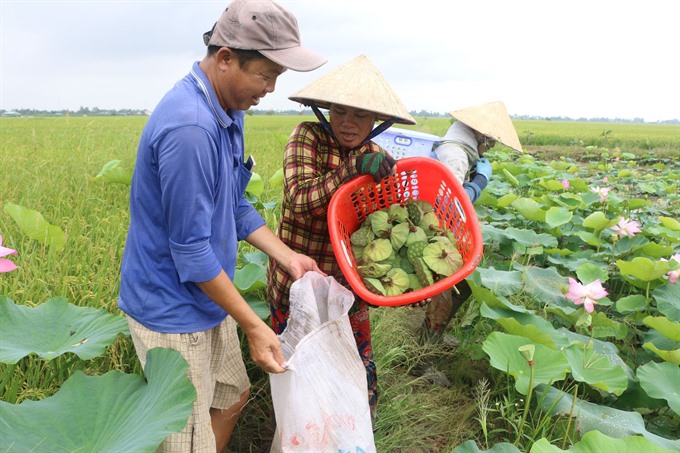 Society
Society

Rice farmers in Đồng Tháp Province, the largest lotus cultivation area in the Mekong Delta, have reaped high profits by planting lotus in their rice fields during the flood season.
 |
| Farmers harvest lotus seeds in Đồng Tháp Province in the Mekong Delta. — VNA/VNS Photo Nguyễn Văn Trí |
HCM CITY — Rice farmers in Đồng Tháp Province, the largest lotus cultivation area in the Mekong Delta, have reaped high profits by planting lotus in their rice fields during the flood season.
For this year’s autumn-winter rice crop, Nguyễn Văn Mười in Thanh Bình District’s Tân Mỹ Commune decided to plant lotus, and not rice.
He is now harvesting his lotus field and estimates that he will receive a high profit of VNĐ50 million (US$2,200) per ha per crop, he said.
The autumn-winter rice crop often has a profit of under VNĐ10 million ($440) per ha and sometimes suffers losses when rice fields are damaged by rain and flood waters.
Lotus plants are easy to grow, require less tending and can flourish in alum-affected soil and flooded areas.
Đồng Tháp has been one of the most flooded provinces during the delta’s annual flood season.
Planting lotus in the flood season can result in profits of between VNĐ50–100 million ($2,200 – 4,400) per ha per crop, according to farmers.
Farmers in the province plant lotus for harvesting mainly lotus seeds or stems.
Lotus plants normally have stems harvested within 40 days of planting, while they have seed harvests after three months of planting.
The harvest period lasts five to six months each crop.
Farmers who plant lotus to harvest seeds can harvest 3.8 tonnes of lotus seed pods per ha per crop. Lotus seed pods are sold at a price VNĐ15,000–16,000 a kilo.
Most parts of lotus plants like seeds, stems, tubers and leaves are used to make food, tea, wine, cosmetics and herbal medicines.
In Đồng Tháp, lotus is planted mostly in Tháp Mười, Cao Lãnh, Tam Nông and Thanh Bình districts.
Lê Văn Ngọt, who has planted 4ha of lotus in the flood season in Tháp Mười District’s Mỹ Hòa Commune, said his family also offers boat services for tourists who want to visit his lotus fields.
His family also serves dishes made from parts of the lotus for tourists.
The income from tourism services is two or three times higher than that from lotus, he said.
Many lotus farmers in Tháp Mười District, Đồng Tháp’s largest lotus cultivation area, also offer tourism services to earn an extra income.
Tháp Mười plans to keep its lotus planting area at 300ha, and will expand in the future as the plant offers higher incomes than rice, according to the district’s People’s Committee. — VNS